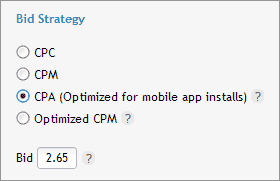As mobile device usage continues to grow rapidly, mobile will be top-priority for many marketers in 2014. Facebook’s massive mobile reach and engaging ad formats make it an essential component of any mobile marketing strategy. Facebook recently pointed out that more than 100 million people access the platform via mobile every day, and people in the US check their Facebook mobile apps, on average, 14 times a day.
In 2013, Facebook made significant enhancements to its mobile advertising offerings, and it now provides a wealth of options to marketers looking to build up their mobile programs. Here are the elements you’ll want to keep in mind as you make your mobile plan for the coming year.
Mobile app ads
It all began with mobile app installs. In a mobile ecosystem flush with apps, visibility is key. Facebook responded to that need by introducing mobile app ads designed to drive discovery and installation of mobile apps. This ad type has showed strong results, with businesses reporting significantly higher CTR and conversion rates.
With improved discoverability and increased app installations, businesses encountered the next-stage challenge: how to keep users coming back to the app that they had already downloaded and installed. As Facebook reported, 66% of app users only open apps between one and 10 times.
So, Facebook took its mobile app ads to the next level – moving beyond installs to app engagement and conversion. With this new ad type, you can deep-link directly to specific content within your app – whether it is an offer for online purchasers, trending flight and hotel packages, new game levels, or an updated playlist. This ad type also features a prominent call to action, such as Shop Now, Book Now, or Play Game.
These two ad types are your core tools for advertising your mobile apps on Facebook. But how do you know what the ROI is from these ads?
Capturing activity and measuring results
Tracking consumer activities within your apps – from the installation to conversion events such as purchases or registrations – is essential for understanding how to get the most out of your mobile app campaigns. Skai’s mobile measurement capabilities enable you to assess and optimize the performance of your mobile app ads by capturing these touch points and enabling analysis through custom reporting and flexible optimization tools.
Bidding for mobile goals
You now have greater control over the Cost per Install (CPI) with Facebook’s introduction of the Cost Per Action (CPA) bid type for mobile app install ads. When using CPA, you are only charged when someone downloads and installs your app. Simply set your maximum amount and Facebook then automatically optimizes your ads to maximize installs while not exceeding your defined CPA.
To optimize your bids for other in-app conversion types, such as reservations, purchases, or game plays, leverage Skai’s Control CPA (Cost Per Acquisition) bid policy. You’ll choose which conversion types to optimize for, and set your CPA goal. Then sit back while Skai’s algorithm automatically bids your ads up or down to achieve the desired CPA.
In the first part of this post on mobile marketing strategies for Facebook, we’ve covered some of the essentials – from the mobile app ad types, to tracking consumer activity in your app, to optimizing your campaigns using bid strategies and policies. Stay tuned for part two, where we’ll take a peek at Facebook’s enhanced ad formats – including the new video creative – and reveal the key targeting options that you’ll want to leverage for mobile campaigns.



